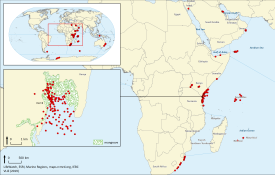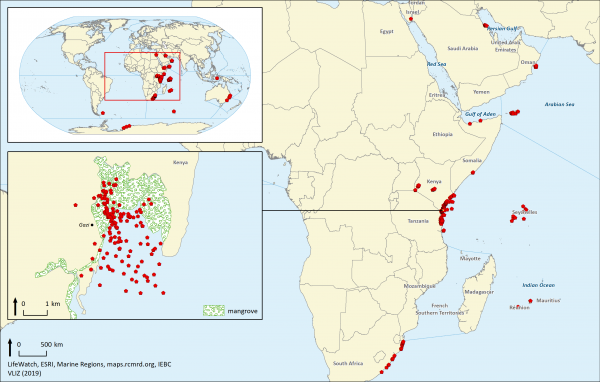NEW DATA PAPER: Biodiversity data rescue in the framework of a long-term Kenya-Belgium cooperation in marine sciences.
The Kenya-Belgium data collection includes about 111.800 biotic observations on benthos, algae, fish, zooplankton, phytoplankton, birds and mangroves which cover more than 400 unique locations that were sampled between 1873 and 1999.

Belgium and Kenya have a long tradition of collaboration in marine sciences. In 2012 the Kenya Marine and Fisheries Institute (KMFRI) and the Flanders Marine Institute (VLIZ) renewed this collaboration with a Memorandum of Understanding (MoU).
One of the activities within this MoU is the recovery of data resulting from marine research in Kenya. In the past, the data collected during the Kenya-Belgium cooperation project (KBP) were mostly scattered and even hidden in the publications and reports coming out of the project. In that way, such data are nowadays hard to find for researchers: a lot of time may be lost when figuring out either where to find the data in literature or what type of data exist in a particular scientific work.
Under the umbrella of the LifeWatch project, potentially high interesting data were digitized, standardized, quality controlled and brought together in one comprehensive dataset. Overall, this data rescue project focused on the digitization and online disclosure of distribution records of observed taxa in both time and space to make these data accessible again for the scientific community.
The methodology and how you can access these data are now published in Nature's Scientific Data journal:
Knockaert, C.; Tyberghein, L.; Goffin, A.; Vanhaecke, D.; Ong'anda, H.; Wakwabi, E.O.; Mees, J. (2019). Biodiversity data rescue in the framework of a long-term Kenya-Belgium cooperation in marine sciences. Scientific Data 6(85): 1-6. https://hdl.handle.net/10.1038/s41597-019-0092-8

One of the activities within this MoU is the recovery of data resulting from marine research in Kenya. In the past, the data collected during the Kenya-Belgium cooperation project (KBP) were mostly scattered and even hidden in the publications and reports coming out of the project. In that way, such data are nowadays hard to find for researchers: a lot of time may be lost when figuring out either where to find the data in literature or what type of data exist in a particular scientific work.
Under the umbrella of the LifeWatch project, potentially high interesting data were digitized, standardized, quality controlled and brought together in one comprehensive dataset. Overall, this data rescue project focused on the digitization and online disclosure of distribution records of observed taxa in both time and space to make these data accessible again for the scientific community.
The methodology and how you can access these data are now published in Nature's Scientific Data journal:
Knockaert, C.; Tyberghein, L.; Goffin, A.; Vanhaecke, D.; Ong'anda, H.; Wakwabi, E.O.; Mees, J. (2019). Biodiversity data rescue in the framework of a long-term Kenya-Belgium cooperation in marine sciences. Scientific Data 6(85): 1-6. https://hdl.handle.net/10.1038/s41597-019-0092-8




